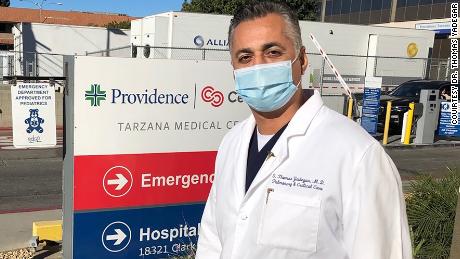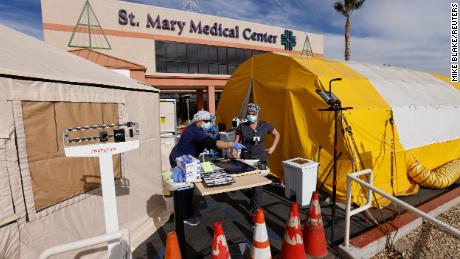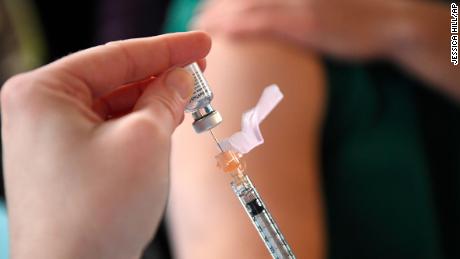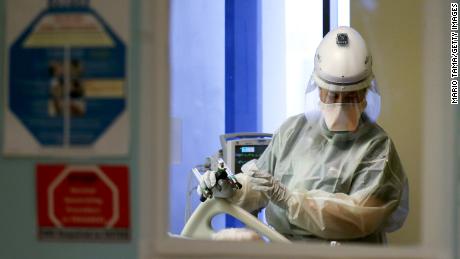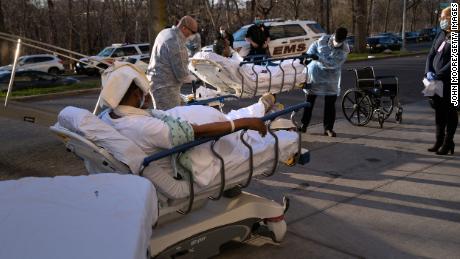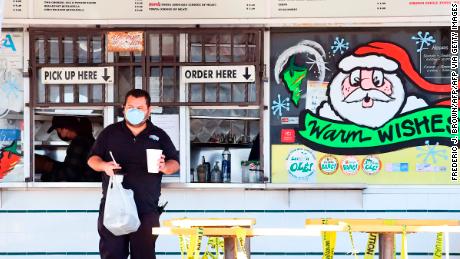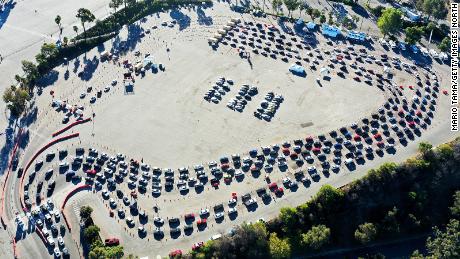‘We are getting crushed.’ What’s behind the alarming rise in California’s Covid cases
ICU bed capacity has plunged to nearly zero in vast portions of the state as patients rush into hospitals, which are struggling to manage strains on resources and personnel.
“We’re experiencing an explosive and very deadly surge,” Los Angeles County Public Health Director Dr. Barbara Ferrer said.
State and local officials are continuing to enact lockdown and quarantine protocols for residents and visitors, even as the Pfizer vaccine rollout has provided some long-term hope. While it may be too early to tell due to the virus’ long incubation time, aggressive stay-at-home measures put forth throughout California two weeks ago have yet to slow the spread.
As the nation’s most populous state and home to approximately 1 in 9 Americans, California would understandably lead in a category such as total cases in a pandemic felt nationwide. However, it is the sheer volume of sick residents and the rate of increase that is particularly driving alarm.
On November 1, the seven-day average for new daily cases in California was 4,183. On Thursday, it was 38,774.
Multiple factors are at play when it comes to California’s sudden acceleration of coronavirus cases, including Covid-19 fatigue, resistance to stay-at-home regulations, the huge number of essential workers and the socioeconomic factors of the pandemic affecting poorer and minority households.
More than 22,000 Californians have died
The California Department of Public Health announced 379 Covid-19 deaths on Thursday, the state’s highest one-day total yet, shattering the prior record of 293 lives lost announced on Wednesday. Friday’s numbers also cleared the earlier record, with 300 deaths reported. More than 22,000 Californians have died from Covid-19.
California’s overall case number is more than 1.7 million, with 52,281 new cases added Thursday. More than 41,000 new cases were announced Friday, as officials noted some were from earlier and had yet been reported.
The daily increase of more than 50,000 cases is staggering for the state, particularly when compared to other outbreaks around the world. According to Johns Hopkins University (JHU) Covid-19 data, California’s daily average of new cases outpaces Canada, Spain and Argentina, all nations with similar populations.
Even more populated countries such as Germany and the United Kingdom have not approached the same level of new infections as California, let alone the entire United States.
“LA County is moving toward becoming the epicenter of the pandemic,” Dr. Brad Spellberg, chief medical officer at LAC + USC Medical Center, warned in a media briefing Friday.
“We’re getting crushed,” Spellberg said about the county’s hospitals. “I’m not going to sugarcoat this. We are getting crushed.”
Hospitalizations in Los Angeles County have doubled since the start of December, according to officials, who have pushed to discharge patients and continue care at home to handle the influx of arrivals.
‘This virus uses our humanity against us’
The arrival of the holiday season led to concern among health officials that families lulled into a false sense of security may gather in large groups over Thanksgiving, sparking infections in multiple households.
The surge may have proven their worries correct.
California, which in months prior did not face the same rate of increase as other parts of the country, accelerated in December to near the top of the list of states per capita with new daily infections, according to JHU data.
“Unfortunately, the stories I hear from the patients, it’s all been the same story. People are just having Covid fatigue,” Dr. Thomas Yadegar, the ICU director at Providence Cedars-Sinai Tarzana Medical Center, told CNN’s Paul Vercammen in an interview Friday.
Yadegar explains that his patients often described practicing social distancing and being mindful until Thanksgiving arrived, even going as far as checking symptoms and testing before meeting family.
“This virus uses our humanity against us. We want to be with our loved ones, especially around the holidays. And unfortunately as soon as you start mixing households, as soon as you come indoors, this is how the virus spreads,” he said.
“We’re going through perhaps the most intense and urgent moment since the beginning of this pandemic,” Gov. Gavin Newsom said Tuesday.
The orders require the closure of businesses like bars, hair salons, museums, movie theaters and indoor recreational facilities. Retail businesses are allowed to stay open at 20% capacity, while restaurants are limited to takeout and delivery service. Travel is prohibited except for essential activities.
“Covid-19 cases are surging in San Francisco and across the country. Hospitals in the Bay Area are close to being overwhelmed,” Mayor London Breed said Thursday. “We must do whatever we can to contain the virus and stop its circulation in our community.”
Essential workers are particularly vulnerable
The frustration of Californians in response to the latest restrictions, however, may be an indicator of Covid-19 fatigue paired with the difficulties of navigating an ever-shifting lockdown landscape that some find inconsistent.
Ruth Benzor, a charge nurse for the Covid-19 unit at Arrowhead Regional Medical in San Bernardino County, told CNN’s Anna-Maja Rappard she sympathized with the small businesses impacted by the pandemic, but she is faced each day treating dying patients with a shrinking number of ICU nurses and beds.
“I definitely want them to work, but they just have to understand that this is real and we just got to, you know, protect each other as a community.”
The state department of health closed access to outdoor playgrounds in early December, yet reversed its decision after public and legislator backlash.
The pandemic’s differing effects on Hispanic, Black, White and Asian communities are also evident.
Dr. Ferrer, the LA County Public Health Director, said on Wednesday that Hispanic residents in the county have been hospitalized at three times the average rate of White and Asian residents since early November. Black residents are twice as likely on average to be hospitalized than White and Asian residents.
Ferrer also noted the socioeconomic consequences of Covid-19 in LA County, stating that the death rate among those living in areas with the fewest resources is now four times higher than those living in the most prosperous.
“The widening gaps are a stark reminder that many of our essential workers are Black and Brown, and many are not able to telework or stay home,” she said.
“Many work at jobs with low wages, and many live in under-resourced neighborhoods. During the surge all our essential workers are taking on increased risk at their jobs because community transmission rates are so high.”
A lesson for the nation to stay diligent
Despite having a supermajority of Democrats in its legislature, California is far from a homogenous bastion of blue. Much like the nation writ large, pockets of a state can have a fervent base of an opposing party’s supporters.
The statistics illustrate the politization of wearing masks and the reluctance to take the threat of Covid-19 seriously has created undue volatility for governments, businesses and individuals alike, and California’s surge can serve as notice for the rest of the nation to stay diligent regardless of location.
“It’s really not California, it’s the entire country, unfortunately,” Dr. Edward Jones-Lopez, an assistant professor at the Keck School of Medicine of USC, told CNN.
Speaking to the need to wear masks and avoid family gatherings, he added, “The next two months are going to be critical to really understand how bad this can be. And even after the vaccine is slowly rolled out, we will need to continue with the basic interventions that we all know now.”
CNN’s Paul Vercammen, Sarah Moon, Cheri Mossburg, Jon Passantino, Melissa Gray, Naomi Thomas, Anna-Maja Rappard, Lucy Kafanov, Jason Hanna and Dakin Andone contributed to this report.
![]()




